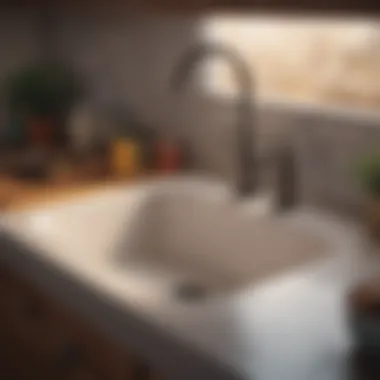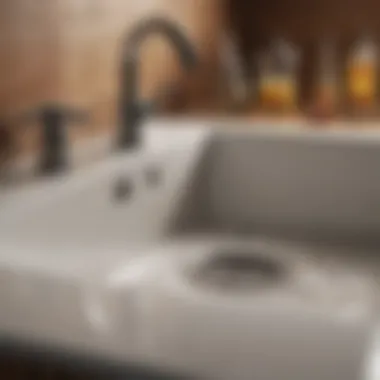Effective Solutions for Clogged Sink Issues


Intro
A clogged sink is not just an inconvenience; it disrupts daily routines and can lead to larger plumbing issues if not addressed promptly. In homes and businesses alike, understanding the causes and solutions to sink blockages is essential. This article aims to provide a detailed guide on effective solutions for a clogged sink, employing household methods and preventive measures.
By recognizing the signs of a clog, homeowners can take early action to prevent more serious problems. Many people could benefit from simple techniques that do not require professional help. This empowers readers with practical knowledge, making them proactive in maintaining their sinks, ultimately saving time and money.
Understanding the Causes of Clogs
Identifying the root causes of sink clogs is crucial. Several common factors contribute to these blockages, including:
- Food Debris: Scraps and grease that go down the drain can solidify and cause serious blockage.
- Hair: In bathroom sinks, hair often accumulates and forms a tangled mess within the pipes.
- Soap Scum: Soap residue can mix with other debris, creating substantial clogs over time.
- Foreign Objects: Items unintentionally dropped into the sink can lead to immediate blockage.
Recognizing these causes can guide effective preventive measures in the future.
Effective Techniques for Unclogging
There are multiple strategies to address clogs, many of which involve everyday items. Here are some practical techniques:
- Boiling Water: Sometimes, pouring boiling water down the drain can dissolve soap scum and grease.
- Baking Soda and Vinegar: This combination creates a mild reaction that can help break down buildup. Pour a half-cup of baking soda followed by a half-cup of vinegar. Cover the drain temporarily and flush it with hot water after a few minutes.
- Plunger: Often overlooked, a basic plunger can effectively dislodge clogs. Make sure to cover any overflow openings and plunge vigorously.
- Manual Removal: If the clog is accessible, wearing gloves and removing debris manually can be an effective approach.
- Plumbing Snake: For more stubborn clogs, a plumbing snake can reach toward deeper blockages. Insert the snake and crank until resistance is felt.
Using these techniques, homeowners can tackle clogs swiftly.
Preventive Measures
To avoid future incidents, consider these preventive strategies:
- Install a Drain Strainer: This captures food particles and hair before they can enter the drain.
- Regular Cleaning: Routine maintenance of drains with hot water every few weeks can help minimize buildup.
- Education: Family members should be aware of what should and shouldn’t be disposed of down a sink.
By taking proactive measures, individuals can prevent the headache of clogged sinks.
Closure
Understanding the Clogged Sink Phenomenon
A clogged sink is not only an inconvenience but also an indicator of underlying issues within a plumbing system. Understanding the clogged sink phenomenon is crucial in order to address it effectively. When sinks become obstructed, they hinder basic household functions, leading to frustration and potential damage to plumbing systems. By grasping the mechanics behind sink clogs, homeowners can better evaluate their situations, apply appropriate solutions, and avert future problems.
Defining the Problem of a Clogged Sink
A clogged sink occurs when water cannot flow freely through the drain. This blockage can stem from various substances accumulating and obstructing pipes. Commonly recognized symptoms include slow drainage, gurgling sounds, or overflowing water. Understanding these signs helps identify the urgency of the situation. When left untreated, clogs can lead to serious plumbing issues, such as leaks or pipe damage, requiring costly repairs.
Common Causes of Sink Clogs
Identifying the cause of a clogged sink is essential for effective resolution. The following are common contributors to sink blockages:
Food Debris Accumulation
Food debris accumulation occurs when small food particles, especially after meals, accumulate in drainage systems. As foood passes through the sink, bits can easily get trapped within pipes. A significant characteristic is that this buildup often affects kitchen sinks more than bathroom ones. This cause is relevant since kitchens generate the majority of drain clogs due to food waste. The downside is that, over time, these small pieces can compact, making the blockage more difficult to remove.
Grease Buildup
Grease buildup is primarily associated with cooking activities. Oils and fats can solidify within the plumbing, creating a sticky residue that attracts food and other debris. This key characteristic makes grease buildup a prominent issue in many households. It is essential to avoid pouring grease directly down the sink to mitigate this problem. However, it's worth noting that grease buildup can be hard to eliminate without proper cleaning techniques, leading to prolonged clog issues.
Hair and Soap Residue
Hair and soap residue typically impact bathroom sinks. When people wash their hands or take showers, hair strands and soap particles often go down the drain. This confluence creates a dense mass over time. The significant aspect of this issue is that it can happen slowly, catching individuals unaware. Another factor is that this buildup can effectively reduce the drain’s diameter, restricting water flow. Regular cleaning can help offset this problem, but it remains a common cause of clogs.
Foreign Objects
Foreign objects also contribute to sink clogs, often occurring more unexpectedly. Small items such as dental floss, cotton swabs, or toys can slip into drains, causing blockages. The key characteristic of foreign objects is their unpredictable nature; homeowners may not realize they are the source of the problem until significant clogging occurs. While less frequent than other causes, they can lead to severe drainage issues and often require professional intervention to remove.
Household Items for Clog Resolution


When dealing with a clogged sink, household items can be remarkably effective. Instead of immediately resorting to chemical drain cleaners, which can be harsh on pipes and the environment, utilizing common pantry items often provides a safer and more sustainable solution. This approach is not only cost-effective but also empowers homeowners to tackle plumbing issues with confidence. It enhances understanding of basic plumbing and encourages proactive maintenance.
Household remedies can be essential in managing minor clogs before they escalate into more severe problems. Additionally, the ease of access to these items means that you can act quickly, reducing downtime in your kitchen or bathroom. Most importantly, these methods are simple enough for anyone to try, fostering independence and resourcefulness.
Baking Soda and Vinegar Method
The combination of baking soda and vinegar is a classic remedy that many people use. This mixture is particularly effective because it creates a chemical reaction that can help break down organic matter in the pipes.
- How It Works: Start by pouring approximately half a cup of baking soda directly into the clogged sink. Follow this with half a cup of vinegar. Allow this to sit for about 15 minutes. During this time, the reaction between the two substances generates carbon dioxide bubbles, which help to dislodge the debris blocking your pipes.
- Rinsing: After the waiting period, flush the sink with hot water to help clear out any remaining material.
This method is both gentle on pipes and efficient in reducing simple clogs caused by food residues or soap scum.
Salt and Boiling Water Treatment
Another simple yet powerful solution is using salt with boiling water. This can be particularly useful for grease buildup or food remnants in your drains.
- Preparation: Heat water until it reaches a rolling boil. Once at this temperature, add a generous amount of salt (about half a cup).
- Application: Carefully pour the boiling salt water into the clogged sink. The high temperature helps to dissolve grease, while the salt adds an abrasive element that can help scrub the pipes free of debris.
This method is effective for maintaining clear drains, as it can be done regularly to prevent buildup over time.
Dish Soap and Hot Water Solution
Using dish soap and hot water is another household remedy that is frequently overlooked. Dish soap works well to cut through grease and food particles.
- Method: Pour a good amount of dish soap directly into the sink. Follow this with hot (not boiling) water.
- Action: Allow the mixture to work for several minutes, then run the faucet with hot water to rinse away any loosened debris.
This method is particularly effective for kitchen sinks where grease may accumulate due to cooking. It is a simple and safe solution that anyone can implement.
Tools for Analyzing and Addressing Clogs
Understanding how to effectively address sink clogs requires appropriate tools. These tools not only help identify the clog’s location but also provide viable solutions for removal. Using the right tools can save time and effort, ultimately leading to a more effective resolution.
The importance of each tool lies in its specific function. For instance, a plunger is simple yet effective for many typical clogs, while more complex devices like snake tools can reach deeper obstructions. Likewise, a wet/dry vacuum offers a powerful, alternative approach. Each tool serves its purpose based on the nature and severity of the clog, thus addressing a range of blockage types.
Plunger Usage and Techniques
A plunger is often the first line of defense against a clogged sink. Its design promotes airflow, which assists in breaking the vacuum effect caused by the clog. By creating a strong suction and pressure on the clog, plungers can dislodge debris, allowing water to flow freely.
To use a plunger effectively, follow these steps:
- Ensure there is enough water in the sink to cover the plunger’s rubber bell.
- Place the plunger over the drain and create a tight seal.
- Push down and pull up rapidly for a duration of around 15-20 seconds.
- Check if water drains; repeat if necessary.
Understanding how to apply the right amount of force and maintain a seal is crucial for successful usage. Care must be taken not to damage pipes, especially if they are older or made of specific materials.
Snake Tool Overview
Snake tools are vital for addressing tougher clogs. They can navigate plumbing and break through to clear blockages that a plunger cannot. Generally, they are flexible, allowing them to maneuver around bends in pipes easily.
Types of Snake Tools
There are several types of snake tools:
- Manual Snakes: These are often hand-cranked and suitable for minor clogs. They are cost-effective and simple to use.
- Motorized Snakes: These provide power and efficiency, suitable for more persistent blockages. They can be used for severe clogs but require more knowledge for effective use.
- Toilet Augers: Specifically designed for toilets, these allow for the clearing of blockages without damaging the toilet seal.
The key characteristic of snake tools is their ability to reach deeper sections of plumbing compared to a plunger. Their flexibility is one of the reasons they are popular in resolving sink clogs, making them a beneficial choice for various situations. However, using a snake tool can be challenging for some, as improper usage may cause pipe damage.
Proper Usage Techniques
To maximize the effectiveness of a snake tool, one must understanding the proper techniques. Always insert the snake gently into the drain, ensuring not to force it too quickly, which might worsen the blockage. Once resistance is felt, slowly turn the handle to break through the obstruction. This method reduces the risk of damaging the pipe.
A unique feature of the snake tool is its adaptability with various attachments, which can enhance its capability to address different types of clogs. However, understanding the snake's mechanism is vital; misuse can lead to frustration and possibly greater issues down the line.
Wet/Dry Vacuum Application


A wet/dry vacuum can provide a powerful solution for clogged sinks. These devices function by sucking out water and debris at the same time, thus providing an immediate solution to both minor and severe clogs. They are particularly useful when a clog is too stubborn for traditional methods.
When using a wet/dry vacuum:
- Remove excess water from the sink to ensure the vacuum can function effectively.
- Attach the appropriate nozzle that fits the sink drain.
- Turn on the vacuum and let it work to pull out the clogged material.
The advantage of using a wet/dry vacuum is its ability to clear clogs without chemical agents, making it an environmentally friendly option. Nevertheless, it can be bulky and may require some effort to set up and operate.
Preventive Strategies for Sink Maintenance
Preventive strategies play a crucial role in maintaining a functional sink and avoiding the distress of clogs. With simple daily and weekly practices, one can significantly reduce the risk of blockages. These habits contribute to the longevity of plumbing systems and enhance overall hygiene in the kitchen or bathroom. Establishing a routine is not just about addressing issues as they arise. It is about preempting future problems and promoting efficient water flow.
Regular Cleaning Routines
Daily Maintenance Tips
Daily maintenance tips include practices that can easily be incorporated into your daily routine. For instance, rinsing food debris down the drain with hot water after meal preparations can prevent accumulation. Simply scraping plates and avoiding pouring grease into sinks can make a notable difference.
The key characteristic of daily maintenance is its simplicity. Such practices do not require extensive time or effort, making them a popular choice for busy households. This commitment to upkeep can be a turning point, ensuring that small remnants do not turn into problematic clogs. The unique feature of this daily approach is its proactive nature, addressing potential issues before they germinate into greater problems.
Weekly Cleaning Suggestions
Weekly cleaning suggestions are designed to give sinks a deeper clean that daily habits might not cover. This can involve using a mixture of baking soda and vinegar weekly. Pouring this solution down the drain can effectively break down soap scum and food particles.
The key characteristic here is the thoroughness that comes from dedicating time once a week to focus on the sinks. This option is seen as beneficial because it targets buildup that may develop from daily use. However, this method does require commitment and consistency. Those who may forget these routines could miss out on the advantages it offers in maintaining clear and functional drains.
Installation of Sink Strainers
Installing sink strainers is a fundamental preventive measure. These small devices catch food particles, hair, and other debris before they enter the plumbing system. The benefit of strainers is their ability to significantly decrease the likelihood of clogs from the outset.
By using strainers, households can tackle potential blockage issues head-on. It is a simple yet effective method. Residents can save time, effort, and expense in the long run. Neglecting to equipped sinks with strainers, however, may result in increased maintenance efforts down the line. Thus, the installation is a low-cost option that brings considerable value to sink maintenance.
When to Seek Professional Help
The decision to call in a professional plumber can be crucial when dealing with a clogged sink. While many issues can be solved using household remedies or basic tools, some situations demand expertise. Understanding when to seek professional help prevents further damage to plumbing systems, saves time, and ensures that the issue is addressed properly. Here are some specific elements and considerations that illustrate the importance of professional intervention in sink maintenance.
Indicators of Severe Clogs
Recognizing severe clog indicators can help you determine whether to attempt a DIY solution or contact a professional. Here are some key signs:
- Persistent Backups: If water continues to back up into the sink despite various home remedies, it may suggest a more serious blockage further down the pipe.
- Unusual Smells: Foul odors are often linked to trapped waste or debris. Such smells indicate that there may be an unresolved clog causing stagnant water.
- Gurgling Noises: Unusual sounds emanating from the sink can signal that air is trapped due to a partial blockage. This may lead to more serious issues if not addressed.
- Multiple Fixtures Affected: If sink clogs affect more than one plumbing fixture in your home simultaneously, this could indicate a more significant problem in the main drainage system.
- Slow Draining Issues: Gradual slow draining can progress into a complete clog. If it lasts longer than a few days, professional consultation is recommended.
Benefits of Professional Services
Engaging a professional plumber offers several benefits that outweigh the initial costs. Key advantages include:
- Expert Diagnosis: Trained professionals can quickly identify the root cause of the clog, often recognizing problems that an untrained person might overlook.
- Specialized Tools and Techniques: Plumbers have access to advanced tools such as hydro-jetting and power augers, which can effectively clear stubborn blockages that traditional methods cannot.
- Preventive Solutions: Professionals can recommend measures to prevent future issues, including pipe inspections and regular maintenance schedules, ensuring long-term functionality of your plumbing system.
- Safety Considerations: Attempting to fix complex plumbing issues can lead to personal injury or damage to your property. Professionals are trained to handle such situations safely.
- Guaranteed Work: Many professional plumbing services offer guarantees on their work, providing peace of mind. If the problem recurs, they often return to fix it at no extra cost.
"When facing persistent plumbing issues, seeking professional help often saves time, resources, and potential headaches down the line."
Eco-Friendly Alternatives to Traditional Solutions
When addressing a clogged sink, many turn to chemical drain cleaners. While effective, these products often contain harsh substances that can harm the environment. Thus, eco-friendly alternatives are increasingly relevant. By seeking out natural solutions, homeowners do not only protect local ecosystems, but they also promote a healthier living space.
Eco-friendly approaches can be as effective as traditional methods. Moreover, they tend to be much safer for your plumbing. Given these benefits, consider integrating more sustainable practices in your home maintenance routines.
Natural Enzyme Cleaners
Natural enzyme cleaners utilize biological enzymes to break down organic materials that contribute to clogs. Unlike chemical-based products, these cleaners can be less harmful to both pipes and the environment. Enzymes are naturally occurring proteins that work by digesting waste materials, effectively preventing buildup.
Benefits of natural enzyme cleaners include:


- Non-toxic for humans and pets
- Safe for all plumbing types
- Long-lasting effectiveness
- Minimal environmental impact
To use, simply apply the cleaner as directed on the label. Allow it to sit overnight if possible, providing ample time for the enzymes to work on the blockage. With consistent use, enzyme cleaners can significantly reduce the occurrence of future clogs, making them a proactive choice for sink maintenance.
Vinegar-Based Solutions
Vinegar is another powerful eco-friendly alternative for unclogging sinks. Its acidic properties make it effective at dissolving grease and mineral buildup. Pairing vinegar with baking soda enhances its effectiveness and adds an effervescent action to the process, which can help dislodge stubborn clogs.
To use a vinegar-based solution, follow these steps:
- Start by pouring baking soda down the affected drain.
- Follow with a cup of vinegar.
- Allow the mixture to fizz and react for at least 30 minutes.
- Flush with hot water afterward.
Using vinegar has additional benefits as well:
- It is inexpensive and widely available.
- It does not leave behind harmful residues.
- It can also be used for routine maintenance, helping to keep drains clear over time.
Using eco-friendly alternatives can save your pipes while protecting the environment. Integrating these methods not only ensures efficient sink maintenance but also promotes a healthier home and planet.
Understanding Local Regulations
Regulations that pertain to waste disposal play a significant role in maintaining proper plumbing systems and public health. Using the correct disposal methods is not just a recommendation but a legal requirement in many areas. This section will explore the importance of being aware of these regulations and how they impact homeowners.
Regulations on Waste Disposal
Every locality has specific rules concerning waste disposal. These regulations ensure that household waste is managed in a manner that safeguards the environment. For instance, many cities prohibit the flushing of certain items down the sink, such as fats, oils, and greases, collectively known as FOG. Not adhering to such regulations can lead to severe clogs not only in individual homes but also in municipal systems.
- Key regulations to consider include:
- Prohibitions on food waste disposal: Many municipalities promote the use of composting instead.
- Guidelines for disposing of chemicals: Some areas prohibit pouring chemicals down the drain due to the potential harm they pose to water systems.
- Enforcement and penalties: Violations may result in fines or other legal consequences, emphasizing the need for compliance.
It is important for homeowners to consult their local laws and regulations to avoid unnecessary incidents. Understanding these guidelines can help prevent not only clogs but also significant damage to plumbing systems.
Impact of Improper Disposal
Improper disposal of waste, particularly in residential plumbing, can have serious ramifications. Blockages caused by inappropriate materials can lead to backflows, which are not only unpleasant but also pose health risks. Additionally, these issues can lead to costly repairs, adding a financial burden on the homeowner.
- Some impacts of improper disposal include:
- Environmental damage: Chemicals and non-biodegradable materials can contaminate local water sources.
- Infrastructure strain: Residential plumbing systems may become overwhelmed, resulting in larger municipal issues.
- Health risks: Standing water from backups can attract pests or lead to mold growth, creating health hazards.
It is crucial to educate everyone in the household about proper disposal practices. Effective communication can drastically reduce the risk of clogs and other plumbing problems.
"Adhering to local regulations is not just about compliance; it is about preserving our environment and health for future generations."
In summary, understanding local regulations regarding waste disposal is a fundamental aspect of maintaining sink functionality. Homeowners should actively seek out this information and implement the necessary practices.
Closure
Summarizing Key Points
Understanding the clogged sink phenomenon is fundamental to finding solutions. The common causes range from food debris accumulation to grease buildup. We discussed practical methods using household items like baking soda and vinegar, which can often serve as effective remedies.
Tools also play an essential role in tackling clogs. A plunger, snake tool, and wet/dry vacuum can provide mechanical assistance for severe blockages.
Preventive strategies are equally important. Regular cleaning routines not only minimize the risk of clogs but also prolong the life of your sink. Installing sink strainers can act as a first line of defense against foreign objects that traditionally cause blockages.
Recognizing when to call a professional can save time and money, especially if indicators of severe clogs appear. The joy of a clean-working sink is significant, and seeking help early can prevent more extensive damage.
Final Recommendations for Sink Maintenance
To ensure your sink remains in good condition, consider implementing these practical strategies:
- Regular Cleaning: Make a habit of cleaning your sink and its associated fixtures frequently. This practice might involve rinsing out food debris or washing hair away.
- Utilize Strainers: Always use sink strainers to catch food particles and hair before they enter the plumbing system.
- Mind What Goes Down the Drain: Be conscious of what you dispose of in your sink. Avoid pouring grease, oils, or fibrous materials that can lead to clogs.
- Periodic Professional Inspections: Schedule periodic plumbing inspections. Professionals can assess the overall condition and suggest preventive measures.
By incorporating these recommendations, you can maintain not only the functionality of your sink but also the overall plumbing system in your home.
A well-maintained sink reflects both care for your property and an understanding of practical home management.
This comprehensive guide serves as a foundation for dealing with clogs and maintaining sink health. With the right methods and preventative measures in place, homeowners can tackle the common yet frustrating issue of clogged sinks effectively.







